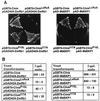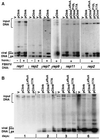Clink, a nanovirus-encoded protein, binds both pRB and SKP1
- PMID: 10708410
- PMCID: PMC111794
- DOI: 10.1128/jvi.74.7.2967-2972.2000
Clink, a nanovirus-encoded protein, binds both pRB and SKP1
Abstract
Clink, a 20-kDa protein of faba bean necrotic yellows virus, a single-stranded DNA plant virus, interacts with pRB family members and a SKP1 homologue from Medicago sativa. An LxCxE motif and an F-box of Clink mediate the interactions with the respective proteins. The capacity of Clink to bind pRB correlates with its ability to stimulate viral replication. Interaction of a single protein with the cell cycle regulator pRB and SKP1, a constituent of the ubiquitin-protein turnover pathway, appears to be a novel feature. Hence, Clink may represent a new class of viral cell cycle modulators.
Figures




References
-
- Amati B, Vlach J. Kip1 meets SKP2: new links in cell-cycle control. Nat Cell Biol. 1999;1:E91–E93. - PubMed
-
- Ausubel F M, Brent R, Kingston R E, Moore D D, Seidman J G, Smith J A, Struhl K, editors. Current protocols in molecular biology. Brooklyn, N.Y: Greene Publishing Associates; 1987.
-
- Bai C, Sen P, Hofmann K, Ma L, Goebl M, Harper J W, Elledge S J. SKP1 connects cell cycle regulators to the ubiquitin proteolysis machinery through a novel motif, the F-box. Cell. 1996;86:263–274. - PubMed
-
- Berezutskaya E, Bagchi S. The human papillomavirus E7 oncoprotein functionally interacts with the S4 subunit of the 26 S proteasome. J Biol Chem. 1997;272:30135–30140. - PubMed
Publication types
MeSH terms
Substances
LinkOut - more resources
Full Text Sources
Other Literature Sources

